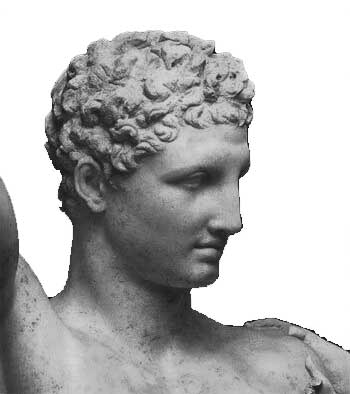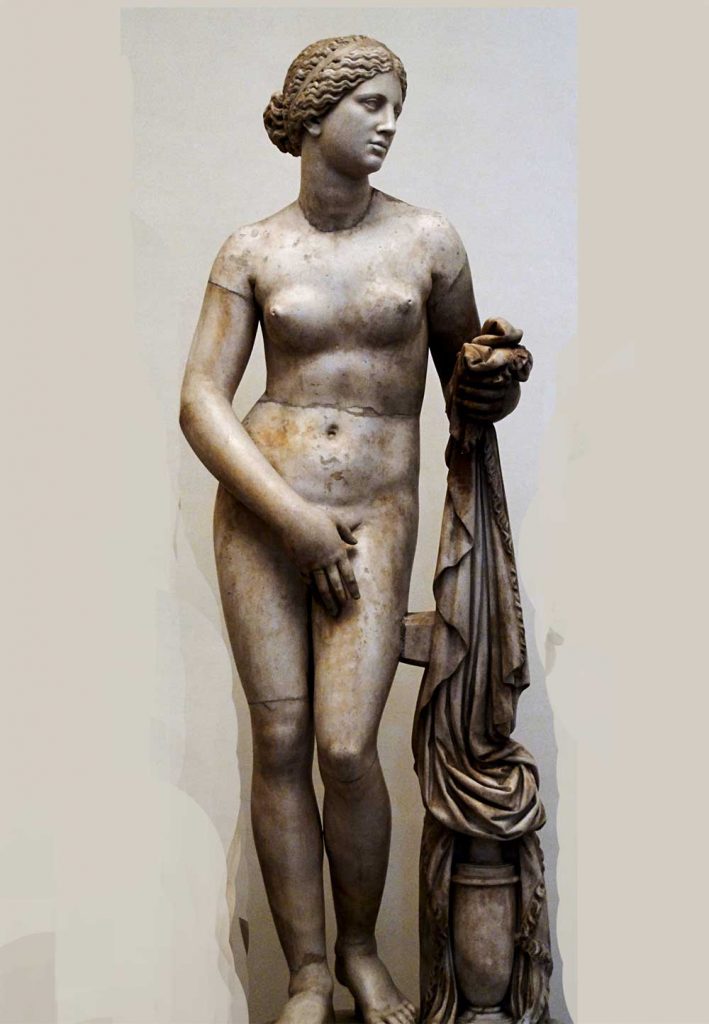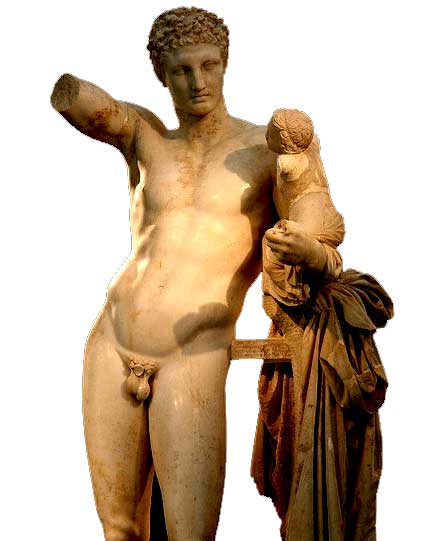The Master Sculptor of Ancient Greece
Praxiteles was born in Athens at the beginning of the 4th century BC (around 395 BC) and was the son or nephew of the already famous sculptor Cephisodotus the Elder, the most renowned Athenian bronze sculptor of the period 390-370 BC. He was an Athenian citizen, likely belonging to the deme of Sybridai.
Cephisodotus was probably also Praxiteles’ teacher, who would have been initiated into the art of sculpture in his father’s workshop, possibly being significantly influenced by his father’s sculpting style. Cephisodotus’ sister married Phocion, a politician and student of Plato.
Through this marriage, Praxiteles’ family must have established ties with Athens’ political leadership and the world of the Academy. This relationship is evidenced by epigrams praising Praxiteles’ most famous work, the Aphrodite of Knidos, attributed to Plato, and an epigram composed by Praxiteles himself to interpret his Eros at Thespiae, reflecting Platonic concepts of love.
Praxiteles was one of the greatest sculptors of antiquity, originating from Athens and being the son of Cephisodotus the Elder. He was the most famous of the Attic sculptors of the 4th century BC and was the first to create life-sized nude female figures. While not many works are unquestionably his, numerous copies of his works have survived.
Ancient Greek and Roman writers, such as Pliny the Elder, wrote about his works. There are also coins bearing silhouettes of his various famous statues from the same period. A supposed relationship between Praxiteles and his beautiful model, the courtesan Phryne, has inspired a range of art works from paintings (Jean-Léon Gérôme) to comic opera (Camille Saint-Saëns) and shadow theater (Donnay).
Some writers have argued that there were two sculptors named Praxiteles, one contemporary with Phidias and another, more famous, who was his grandson. Though repeating the same name across generations is common in Greece, there is no specific evidence to support this.
General Timotheus, who restored Athenian hegemony with the Panhellenic Peace of 374 BC, commissioned Cephisodotus to create a bronze group featuring Peace holding Plutus as a baby. Thus, regarding his upbringing, Praxiteles must have benefited from the political protection this general afforded his father and his workshop.
In his youth, Praxiteles began to specialize in marble sculpture, in line with the growing preference for marble-surfaced sculptures and the belief that marble sculptures revealed what was already present within the marble, a theory in agreement with Platonic condemnation of imitation in the visual arts.
His Works
 Praxiteles was a particularly productive sculptor who primarily worked with marble, though some of his finest works were in bronze. He had a unique ability to capture sweetness and tenderness in his works, in contrast to Scopas, who infused his sculptures with intense passion. Praxiteles had two sons, Timarchus and Cephisodotus the Younger, who followed in their father’s profession.
Praxiteles was a particularly productive sculptor who primarily worked with marble, though some of his finest works were in bronze. He had a unique ability to capture sweetness and tenderness in his works, in contrast to Scopas, who infused his sculptures with intense passion. Praxiteles had two sons, Timarchus and Cephisodotus the Younger, who followed in their father’s profession.
He is known to have created statues for Athenian devotees of the Eleusinian Mysteries and for patrons of choragic monuments. The name of a commissioner of a Praxiteles statue set up at Leuctra is attested epigraphically.
The information that Praxiteles worked on the Mausoleum at Halicarnassus indicates his association with the royal house of Caria. Additionally, the fact that Praxiteles’ statues were found in antiquity in locations such as Athens, Megara, Corinth, Argos, Mantinea, Olympia, Elis, Plataea, Thebes, Thespiae, Levadia, Delphi, Antikyra, Kos, Knidos, Parion, Olbia Pontica, Ephesus, Alexandria in Latmos, and Myra means that he was in contact with commissioners and buyers of statues from these centers.
The Spartans commissioned an Aphrodite from him in the late 340s BC but refused to accept the statue because he used the courtesan Phryne as a model, despite the Athenian sculptor’s vain attempts to persuade them.
The Spartans rejected the statue as Aphrodite in Sparta was worshipped as a goddess of love in marriage, not of love with courtesans. The Thespians requested a gilded statue of Phryne, which was placed on a high column at Delphi. One day, Praxiteles discovered that he was no longer a slave to love and represented this new state with his “Sleeping Eros.”
We know of three artists who grew up in his workshop: the Athenian painter Nicias, who as a young man painted the surfaces of his marble sculptures, the bronze sculptor Herodotus from Olynthus, who collaborated on a bronze statue of Phryne, and finally his pupil Papylos. Praxiteles must have been wealthy, as his finances allowed him to have as a lover the most famous and undoubtedly the most expensive courtesan of his time, Phryne.
Moreover, he was one of about 300 Athenians who were required to pay public contributions. His family’s connection with the oligarchic politician Phocion and his relationship with Plato’s Academy suggest he likely held oligarchic views. The main characteristics of his art have also been interpreted as evidence of oligarchic ideology.
His Private Life
Praxiteles was married and had two sons, the elder named Cephisodotus (also called “the Younger” to distinguish him from an older namesake who was likely Praxiteles’ father) and the younger Timarchus. Both of them worked as sculptors. Cephisodotus the Younger succeeded Praxiteles at the helm of the workshop when he retired, possibly in 334 BC or a little later.
The courtesan Cratina was another lover of Praxiteles as well as the model for the face of the Aphrodite of Knidos. A third courtesan, Glycera, is also mentioned as a lover of his.
Most famous Statues of Praxiteles
Praxiteles, one of the most celebrated sculptors of ancient Greece, is renowned for his refined and realistic depictions of the human form, particularly in marble. His works are marked by their elegance, grace, and the subtle play of light and shadow, which added a softness and lifelike quality to the sculptures. Although many of his original works are lost to history, Roman copies and historical texts provide insight into his mastery. Here are some of his most famous statues:
Aphrodite of Knidos
The Aphrodite of Knidos is considered Praxiteles’ masterpiece and one of the most celebrated sculptures of ancient times. It was revolutionary for being the first full-sized representation of the nude female form, a daring departure from the modesty of earlier female statues. The goddess is depicted at the moment before taking a bath, her posture subtly suggesting modesty, yet confident in her divine beauty. This statue became a major tourist attraction in antiquity, drawing visitors from all over the Greek world. Unfortunately, the original work has been lost, but numerous Roman copies and descriptions survive.

Eros of Thespiae
The Eros of Thespiae, another acclaimed work by Praxiteles, depicted the god of love, Eros, in a relaxed, contemplative pose, which was a significant departure from the traditional representations of gods in Greek art. The statue was celebrated for its delicate beauty and for capturing the youthful god in a moment of introspection. Although the original statue is lost, it was highly influential in later art and contributed to the popularization of Eros as a subject in Hellenistic and Roman sculpture.
Hermes and the Infant Dionysus
One of the few works attributed to Praxiteles that survives in part today is the Hermes and the Infant Dionysus, discovered in the Temple of Hera at Olympia. The statue shows Hermes, the messenger of the gods, holding the infant Dionysus. It is admired for its exquisite representation of the male form and for the tender interaction between the god and the child. The statue’s composition, with Hermes captured in a moment of action, showcases Praxiteles’ skill in creating dynamic and realistic figures.

Satyr Pouring Wine (The Pouring Satyr)
Although the original statue has not survived, the Pouring Satyr is known through Roman copies and is another testament to Praxiteles’ talent for capturing life-like poses and imbuing his subjects with a sense of vitality. The satyr is depicted in a moment of casual action, pouring wine, which was a departure from the more formal and idealized representations of mythological figures prevalent in earlier Greek art.
Apollo Sauroktonos (The Lizard-Slayer)
The Apollo Sauroktonos portrays a youthful Apollo about to kill a lizard that has crawled up a tree. This work is noted for its delicate realism and the youthful grace of Apollo, depicted in a moment of boyish curiosity rather than in his traditional godly stature. The original bronze statue is lost, but several Roman marble copies provide insight into its composition and style.
Praxiteles’ work signifies a shift towards more naturalistic and humanized depictions of gods and figures from mythology, highlighting his ability to convey psychological depth and physical beauty. His influence on the development of classical sculpture cannot be overstated, with his innovations in form and subject matter continuing to inspire artists for centuries.
